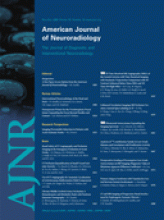Abstract
BACKGROUND AND PURPOSE: Current knowledge of the collateral circulation remains sparse, and a noninvasive method to better characterize the role of collaterals is desirable. The aim of our study was to investigate the presence and distal flow of collaterals by using a new MR perfusion territory imaging, vessel-encoded arterial spin-labeling (VE-ASL).
MATERIALS AND METHODS: Fifty-six patients with internal carotid artery (ICA) or middle cerebral artery (MCA) stenosis were identified by sonography. VE-ASL was performed to assess the presence and function of collateral flow. The perfusion information was combined with VE maps into high signal-intensity-to-noise-ratio 3-colored maps of the left carotid, right carotid, and posterior circulation territories. The presence of the anterior and posterior collateral flow was demonstrated by the color of the standard anterior cerebral artery/MCA flow territory. The distal function of collateral flow was categorized as adequate (cerebral blood flow [CBF] ≥10 mL/min/100 g) or deficient (CBF <10 mL/min/100 g). The results were compared with those of MR angiography (MRA) and intra-arterial digital subtraction angiography (DSA) in cross table, and κ coefficients were calculated to determine the agreement among different methods.
RESULTS: The κ coefficients of the presence of anterior and posterior collaterals by using VE-ASL and MRA were 0.785 and 0.700, respectively. The κ coefficient of the function of collaterals by using VE-ASL and DSA was 0.726. Apart from collaterals through the circle of Willis, VE-ASL showed collateral flow via leptomeningeal anastomoses.
CONCLUSIONS: In patients with ICA or MCA stenosis, VE-ASL could show the presence, the origin, and distal function of collateral flow noninvasively.
- Copyright © American Society of Neuroradiology












